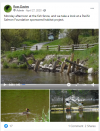Bryan Allen
Well-Known Member
I know we keep getting told that the limiting factor is not available habitat that will solve our salmon crisis. But maybe its time to look past our province ( like we did 25yrs ago with Wa and Or volunteer projects ) down south. This project on the Clackamus in Or is a ramping up of introducing LWD for improving salmon habitat. No more spending effort and dollars introducing LWD, only to see it washed away with the first fall storm.... Live and learn guys-- Bigger IS better

